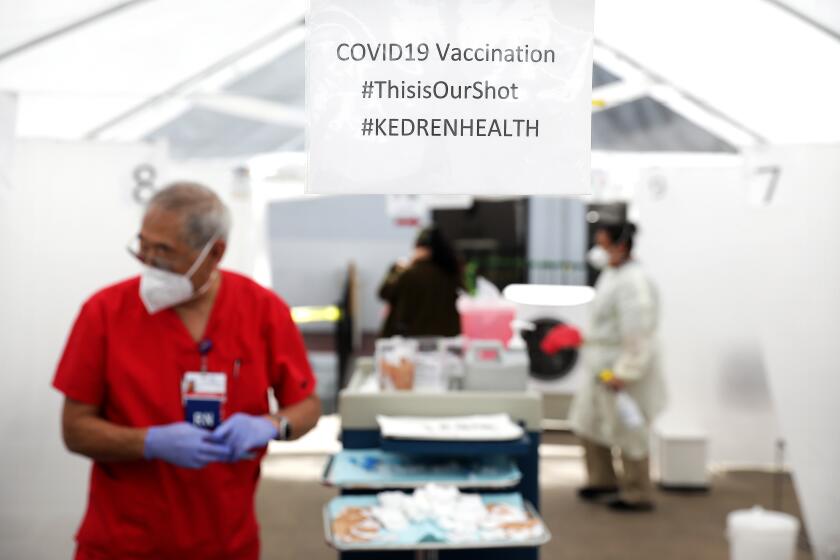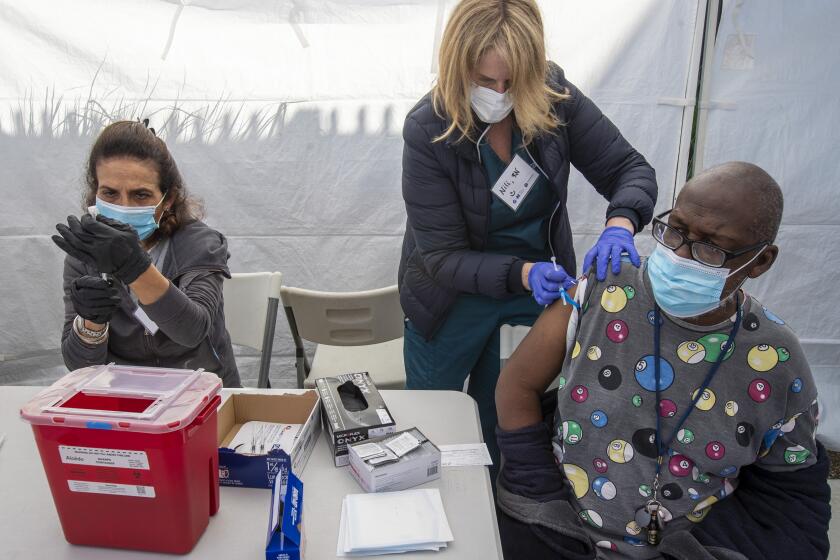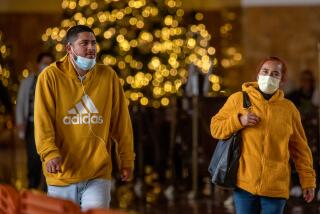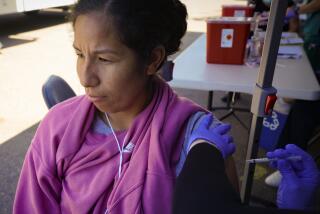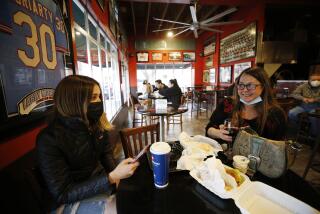L.A., O.C. reach orange-tier coronavirus numbers; wider reopening could be a week away
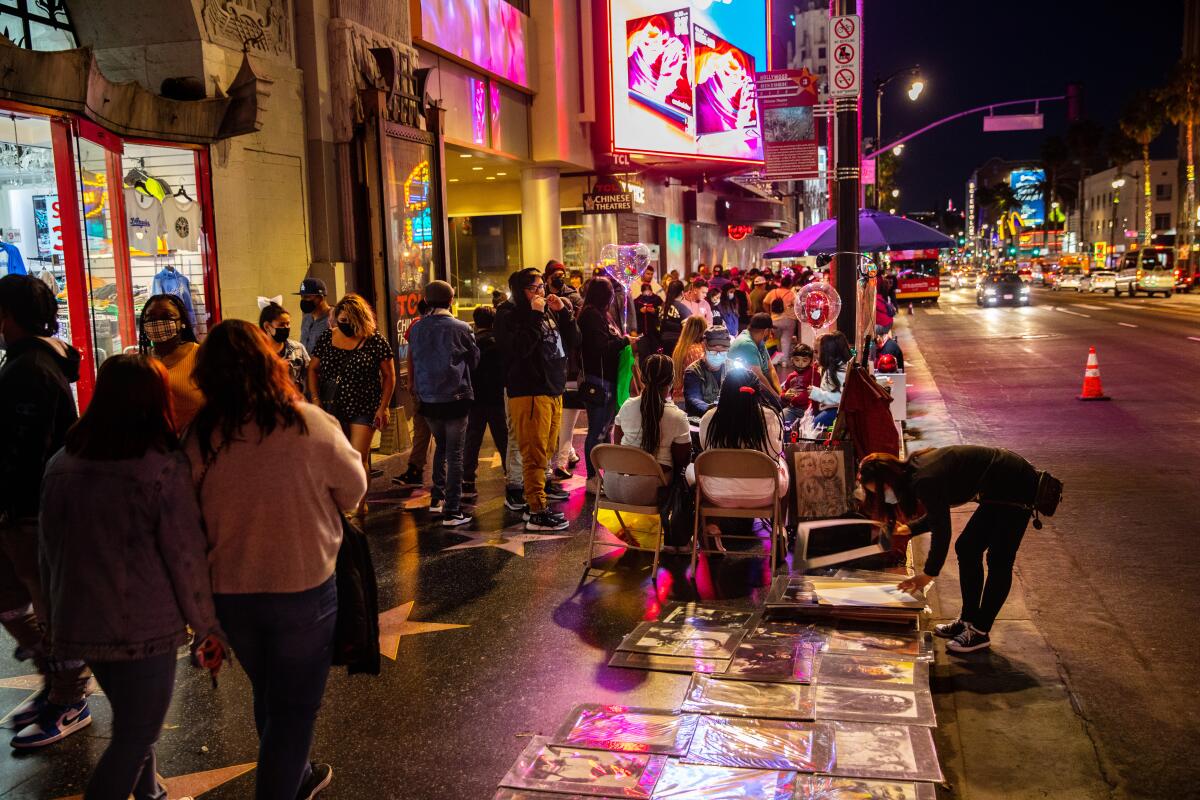
- Share via
A receding coronavirus wave has Los Angeles and Orange counties on the precipice of additional openings.
The counties — California’s most and third-most populous, respectively — have banked one week’s worth of the coronavirus numbers needed to progress to the orange tier of the state’s reopening plan — a move that would allow a more widespread unlocking of businesses and other public spaces.
The counties’ progression, which could happen as soon as next week if their metrics hold steady, would accelerate the dash up the state’s reopening ladder. The past few weeks have seen the majority of California counties improve to the point that they’ve been able to cast off the state’s tightest restrictions to combat the spread of COVID-19.
The latest status of school reopenings in California.
Under the state’s reopening strategy, counties are sorted into four color-coded tiers; purple, in which coronavirus transmission is considered widespread, and indoor operations are severely limited or outright suspended across a wide array of business sectors; red, with fewer restrictions; orange, with even fewer; and finally, yellow, in which most businesses can open indoors with modifications.
Tier assignments hinge on three factors: coronavirus case rates, adjusted based on the number of tests performed; the rate of positive test results; and a health-equity metric intended to ensure that the positive test rate in poorer communities is not significantly higher than the county’s overall figure.
While California has made tremendous progress following a COVID-19 surge in the fall and winter, the orange and yellow tiers remain a fairly exclusive club.
According to state data released Tuesday, six counties will move into the orange tier this week: San Francisco, Santa Clara, Marin, Trinity, Lassen and Yolo. Already in that tier are Mariposa, Plumas and San Mateo counties. Just two counties, Alpine and Sierra, have made it to yellow.
San Francisco Mayor London Breed dressed for the occasion Tuesday, sporting an orange outfit as she addressed reporters.
Moving into the orange tier, she said, means “downtown is going to start to come alive again,” and “many of the restaurants and the coffee shops in the places that you’ve seen that have been struggling will hopefully be able to open again.”
Despite the rosy news, officials continue to stress that the hard-fought progress is fragile and could be reversed if residents or businesses are too quick to abandon public health measures.
“We don’t want to get too comfortable,” Breed said. “We know that there is still work to do. We don’t want to see another surge. We don’t want to go backward. That’s why we are proceeding with caution in how we open.”
Staying on the path forward, she said, means “we all still have a role to play — in getting the vaccine when we qualify and making sure that we’re continuing to wear our mask and socially distance and do all of those things.”
Dr. Sara Cody, Santa Clara County’s health officer and public health director, said moving to the orange tier “reflects the patience and persistence of the whole community.”
“To continue to prevent cases and resultant hospitalizations and deaths, we must continue to wear masks, social distance, stay outdoors as much as possible and get vaccinated when it’s our turn,” she said in a statement. “We are close to a significant increase in vaccine supplies, but until those doses are in arms, we must protect each other against another surge.”
Even as the state’s numbers remain comparatively positive, officials are urging caution, saying California can ill afford to see its progress reverse.
Moving into the red tier this week were Kern, Nevada and Stanislaus counties.
Kern’s progression means the entire southern third of the state has moved out of the purple tier — a dramatic change from the fall and winter, when the region was hit especially hard.
Thirty-nine California counties, home to a combined 33.4 million residents, are now in the red tier. Only eight — Fresno, Glenn, Inyo, Kings, Madera, Merced, San Joaquin and Yuba — remain in the most-restrictive purple.
Reaching the orange tier requires a county to have an adjusted rate of 3.9 or fewer new coronavirus cases per 100,000 people each day, a test positivity rate of under 5% and a health equity metric of less than 5.3%.
L.A. and Orange counties have checked all those boxes, state data show. Their most recently calculated adjusted case rates were 3.7 and 3.5, respectively.
Counties must log two straight weeks of qualifying data to advance to a less restrictive tier and have to stay in a tier at least three weeks before moving again. As an example, Alameda, Colusa and Santa Cruz counties have banked two straight weeks of orange-worthy data but have to wait to advance because they haven’t been in the red tier long enough.
In addition to L.A. and Orange, other counties that must maintain their metrics to potentially move to the orange tier next week are Butte, Calaveras, El Dorado, Imperial, Modoc, Napa and Tuolumne.
“It’s certainly good news that we’re making progress, reducing transmission across the county,” L.A. County Public Health Director Barbara Ferrer said Tuesday. “However, we continue to remain concerned about the potential risks that can thwart our progress.”
Potential roadblocks, she said, include the myriad coronavirus variants — some of which have been found to be even more infectious — and worrisome upticks in case numbers in Europe and the United States.
“While conditions have definitely changed, particularly as we’ve vaccinated millions of individuals over the past three months, we do not yet have enough vaccine protection across the county to prevent more transmission if we’re not extraordinarily careful in these next few weeks,” Ferrer told the county Board of Supervisors on Tuesday.
Since the start of the pandemic, scores of Angelenos have moved to Taiwan, where they have roots and coronavirus spread has been kept in check.
Upon reaching the orange tier, counties can allow bars to reopen outdoors, with modifications, without needing to serve food.
Additionally, capacity restrictions are lifted in stores (although pandemic safety modifications still apply); houses of worship, museums, zoos and aquariums can raise their indoor capacity from 25% to 50%; restaurants and movie theaters can raise indoor capacity from 25% or 100 people (whichever is fewer) to 50% capacity or 200 people; and indoor gyms and yoga studios increase from 10% to 25%. Bowling alleys can reopen with modifications at 25% capacity. Card rooms and satellite wagering sites can also reopen indoors at 25% capacity.
Additionally, offices in nonessential industries can reopen, but workers should be encouraged to work remotely.
Amusement parks — which can open starting April 1 in red-tier counties — would be allowed to expand their attendance to 25% capacity.
The capacity limit for outdoor sports and live performances, also effective April 1, rises to 33% for counties in the orange tier.
Even when state criteria are met, however, counties may choose to maintain stricter reopening rules.
L.A. County is focusing on second doses, but the bottleneck will be less severe at sites run by the city. L.A. officials say they’ll offer 70,000 shots this week.
The recent advancements of counties through the state’s tier system were made possible in part by a new strategy that eases the criteria required to progress as more of the most vulnerable Californians are vaccinated.
State officials set an initial goal of administering 2 million COVID-19 vaccine doses in targeted disadvantaged communities — those within the lowest quartile of a socioeconomic measurement tool called the California Healthy Places Index — and a stretch target of 4 million doses.
To support that effort, the state is devoting 40% of its available COVID-19 vaccine to residents in those areas.
When California cleared its first self-imposed vaccination goal earlier this month, the state began allowing counties with an adjusted case rate of up to 10 new cases per day per 100,000 people to exit the purple tier. Previously, counties needed to have case rates at or below seven to move from purple to red.
The lower threshold cleared the way for many counties, including much of Southern California, to enter the red tier quicker than they would have before.
Once the state hits 4 million vaccinations, the threshold to move into the orange tier will be relaxed from four new cases per day per 100,000 residents to six. Entering the yellow tier would necessitate an adjusted daily new case rate below two, compared with the current requirement of less than one.
Reaching that point will take time, however. As of Tuesday morning, about 2.9 million vaccine doses had been administered in the targeted communities, state data show.
More to Read
Sign up for Essential California
The most important California stories and recommendations in your inbox every morning.
You may occasionally receive promotional content from the Los Angeles Times.

